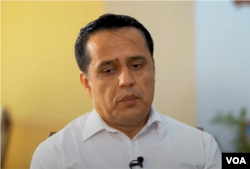They’ve been waiting for years, sometimes decades, not knowing if their loved ones – victims of enforced disappearances in South Asia – are dead or alive.
The uncertainty over their fate gnaws, yet it also keeps them going.
Farzana Akhtar’s husband, Parvez Hossain, was taken by Bangladeshi security forces 11 years ago. An opposition activist, he was one of more than 600 people forcibly disappeared during former Prime Minister Sheikh Hasina’s rule from 2009 to 2024. While some were released or reported dead, more than 100 are unaccounted for.
Hope for their freedom surged after Hasina’s government collapsed on August 5 in the face of student protests. Three people were released from a notorious detention center in Dhaka, but desperate families that rushed to the site found only empty cells.
Still, Akhtar clings to hope that her husband is alive.
“For this, we hope there are people,” Akhtar said.
Her daughter, Abida Islam Ridi, was just 2 years old when her father vanished. Watching a video of the detention center, she felt a chill of fear.
“How could people stay there?” she said.
Yet, like her mother, she holds onto the hope that her father is alive.
“My mother says I have a father,” Ridi said. “Everyone says they will return my father. But they don’t say where. Everyone just says, you have a father.”
This hope mingled with anguish is echoed by nearly a dozen family members in Afghanistan, Bangladesh, and Pakistan interviewed by VOA.
To human rights activists, the feeling is all too familiar.
“In Sri Lanka, the war ended in 2009 and yet we meet mothers who are still hoping that their sons may be in some secret arrest place and that they will be returned,” said Meenakshi Ganguly, deputy Asia director at Human Rights Watch.
Enforced disappearances are a grave human rights violation. Victims are grabbed off the street or taken from their homes by security forces. Their fate remains unknown: They might be held indefinitely, released, or die in custody. The practice, made notorious by Latin America’s military regimes in the 1960s, has plagued South Asia for decades.
Across the region, the toll is enormous. In Afghanistan, tens of thousands were forcibly disappeared in the late 1970s. In Sri Lanka, between 60,000 and 100,000 have disappeared since the 1980s. In India’s Kashmir region, at least 8,000 cases were recorded between 1989 and 2012. In Pakistan’s Baluchistan, 7,000 cases have been recorded since 2004.
Governments accused of carrying out enforced disappearances deny the allegations. Hasina’s regime often insisted that some of the victims had gone into hiding to evade criminal charges. But Bangladesh’s new interim government has set up a commission to investigate and signed the International Convention for the Protection of All Persons from Enforced Disappearances.
The lack of closure, human rights experts say, is the worst aspect of the practice: Family members would rather receive a body than not know.
“There is nothing more difficult than this,” said Fahima Bibi, whose son, Abdul Khalid, vanished in Pakistan’s Punjab province in 2012. “If a person dies, your heart gets closure, but not knowing if they are dead or alive?”
The long-term psychological effects on families are uncertain. A 2015 study found that post traumatic stress disorder, depression, and complicated grief are more common among these families than in people coping with the death of a loved one. A more recent study, however, found that the evidence is inconclusive.
The vast majority of victims are men, their children bearing the burden of their loss, even those too young to remember them. They come to know them through pictures, mementos, and family stories, forming an imaginary bond. The void becomes painful when they see peers with their fathers.
Fahmida Baloch was 2 when her father, Dr. Muhammad Akbar Marri, was taken from his clinic in Baluchistan by Pakistani paramilitary forces in 2010. Initially telling her that her father had gone on a business trip, Baloch’s mother disclosed the truth when she was about 8 years old.
“I didn’t know before what enforced disappearance meant,” she said.
Little things conjured her father’s absence: fathers picking up their children at school, teachers asking students to bring their fathers to school.
“How could I tell them where my father was?” Baloch said.
She drew strength and hope from her Islamic faith.
“My mother says, ‘Keep up your hope, he’ll definitely come back,'” she says. “I pray. Other than praying, I can’t do anything.”
This hope sustains others well into their middle years.
Farhad Ashkyar’s father was seized in Kabul in 1979. Farhad was 2 at the time. As he grew, he learned about his absent father from family stories: He was a health ministry employee and a good wrestler.
Like Baloch, seeing other children with their fathers sharpened his sense of loss.
“There is nothing harder than it, especially when you see other kids call their fathers or say, ‘My father is getting me new clothes for Eid,” he said.
Through the years of his father’s absence, the family clung to every rumor, every whisper of hope, every late-night knock on the door.
“The thing is we were always waiting,” Ashkyar said.
Waiting but also standing tall. “I realized that whether he comes back or not, I have to stand on my own feet. I have to work hard.”
Then, in 2013, the families of victims found a measure of closure. A list of nearly 5,000 people forcibly disappeared and executed following the 1978 Communist coup surfaced. For many families, the list brought some solace, if not the bodies, at least an acknowledgement. To honor their memory, they held funeral and prayer services.
But Ashkyar’s father’s name wasn’t on the list.
“That gave us hope,” he said. “If he had been killed, his name would have appeared on the list. To this day, I can’t say ‘May God forgive him,’ because we haven’t seen his body.”
VOA’s Afghan, Bangla, Deewa, and Urdu services contributed to this article.



